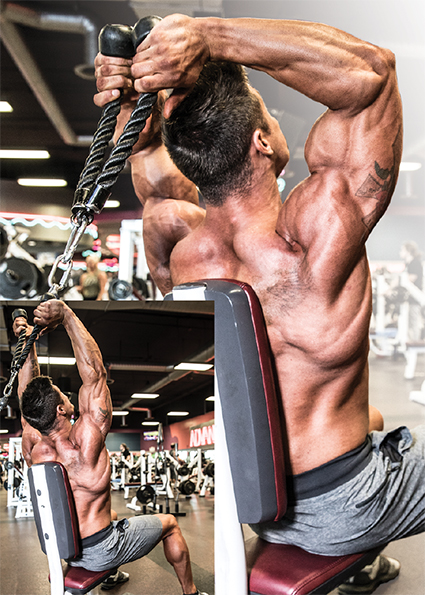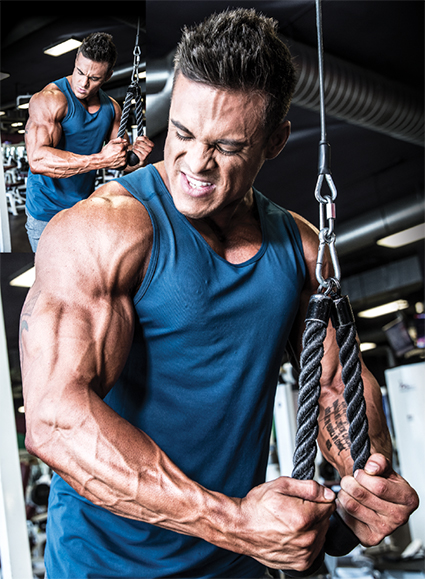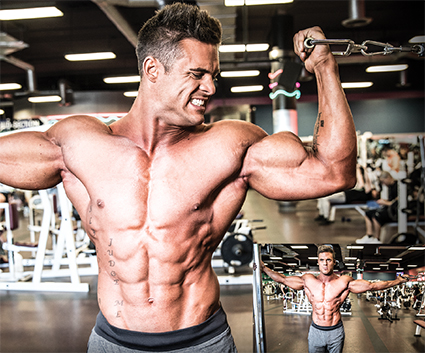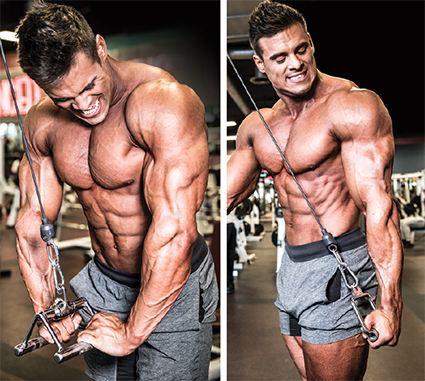FORGE BIGGER ARMS NOW!

FORGE BIGGER ARMS NOW!
You gotta try Muscle Insider’s unique all-cable arm workout—featuring superstar Logan Franklin—to blow up your biceps and triceps.
There’s no denying that one of the most revealing signs of someone’s hard work in the gym is a pair of big arms bursting out of their T-shirt. No matter where you are—be it the beach, the boardroom, or the bedroom—well-developed arms represent strength, command respect, and suggest a sexual prowess.
It can’t come as any surprise, then, that we will always make time to get our arm workout in. It doesn’t matter how busy your day was or how tired you are, you will find time to train your biceps and triceps by any means possible.
It’s Friday and you find yourself at the end of the day, still needing to get in a workout before you head out to the club, and you’re forced to sneak in a quick workout at your condo gym. Or you’re in another city, having travelled for work, and are forced to get up for an early morning workout in the hotel gym before your breakfast meeting. In either case, you’re usually faced with using an ill-equipped gym with a small set of dumbbells and an adjustable cable station. But don’t fret, my friend!
For when you’re in a time crunch but need to still get your workout in, here’s an effective arm workout using cable exercises exclusively. I assure you, using only cables doesn’t mean you can’t achieve a high-quality workout. In fact, I want to make a case for cable exercises, especially for smaller body parts such as biceps and triceps, as I believe cable exercises offer some advantages over free weights (barbells and dumbbells).

ADVANTAGES
Cables Offer Constant Tension
When performing a cable exercise, there’s a uniform amount of resistance on the target muscle regardless of the point in the range of motion. This isn’t the case when using free weights. Using the biceps dumbbell curl exercise as the example, the greatest amount of resistance is met by the biceps when the load (i.e., the dumbbell) reaches the midpoint in the curl. Beyond that point, your elbow bends more than 90 degrees and less.
Cables Allow a Change in the Line of Resistance
When using free weights, the angle of resistance is solely based on gravity. This means that the line of resistance is always going to be perpendicular to the floor. In contrast, when performing a cable exercise, you can adjust the height of the pulley. This allows you to manipulate the angle of resistance and provide a different stimulation. Bodybuilders particularly like hitting their muscles from different angles to optimize complete muscular development. Athletes having to work around an injury can also enjoy the freedom of changing the exercise angle to fit their current abilities.
Cables Provide Variety
There’s no denying that free weights (i.e., dumbbells and barbells) will remain the foundation of any serious athlete’s weight-training program. But as with anything else, too much of the same thing can become monotonous. With the addition of cable exercises, you can add some diversity to your training, which can bring new motivation and new gains.

PRACTICAL APPLICATION
To get you out of the gym as fast as possible while still being able to get a great training session in, here’s an effective workout that offers the advantages of using cables but also employs supersets to maximize your training intensity and your time in the gym.
Workout Description:
You’re going to superset one triceps exercise with one biceps exercise.
Complete all four supersets of the two exercises and then rest for two minutes—enough time to grab a sip of water and adjust the pulleys and weights to get ready for the next superset.
What Is a Superset?
A superset is when you perform one set of an exercise and then, without rest, perform one set of a different exercise. Normally, once one superset is completed, you would take a rest before starting another superset. But for this workout, we’re going to take it up another notch and not rest until all four supersets of the A exercises are completed, then all B exercises, and ultimately, all C exercises.
You see, when you’re performing the first exercise—in this case, a triceps exercise—the biceps are resting. When you’re performing the second exercise—in this case, a biceps exercise—the triceps are resting. So, you can go back and forth, performing one set of the first exercise then one set of the second exercise without rest until all four supersets are completed. This not only increases training intensity but also increases total arm muscle pump and saves time.
Your All-Cable Arm Blitz
A1. Seated low pulley overhead rope cable triceps extension: 4 sets of 10 repetitions each, no rest
A2. Low pulley EZ-bar biceps cable curl: 4 sets of 10 repetitions each, no rest.
Once 4 supersets are completed, rest 2 minutes.
B1. Rope triceps push-down: 4 sets of 12 repetitions each, no rest
B2. Low pulley rope hammer curl: 4 sets of 12 repetitions each, no rest.
Once 4 supersets are completed, rest 2 minutes.
C1. One-arm low pulley D-handle triceps kickback: 4 sets of 15 repetitions for each arm, no rest
C2. One-arm high pulley D-handle cable biceps concentration curl: 4 sets of 15 repetitions for each arm, no rest.
Once 4 supersets are completed, go shower and get to your meeting.
Exercise Descriptions:
A1. Seated Low Pulley Overhead Rope Cable Triceps Extension
Start: Grab the rope behind your neck with a neutral grip (palms facing each other). While keeping your hands close together, sit down with your back flat against the bench. Note: This will pre-lift the weight slightly from the stack so there will be tension right from the bottom.
Movement: While keeping your elbows pointed at the ceiling, slowly push straight up against the rope until your triceps are fully contracted while you exhale (breathe out). As you extend your arms up towards the ceiling, keep the rope ends apart. Continue extending the weight overhead until your triceps are fully contracted. Hold the top position for a moment before slowly bringing the rope back down to the starting position. Breathe in as you lower the rope back down.

A2. Low Pulley EZ-Bar Biceps Cable Curl
Start: Grab the EZ-bar attachment with a supinated grip (palms up) at shoulder width apart. Keep your elbows close to your torso.
Movement: While keeping your upper arms stationary, curl the EZ-bar attachment using biceps contraction as you exhale (breathe out). Continue curling the weight until your biceps are fully contracted and the EZ-bar attachment reaches shoulder height. Pause for a moment in the top position and squeeze both of your biceps before slowly bringing the EZ-bar attachment back to the starting position. Breathe in as you lower the EZ-bar back down.

B1. Rope Triceps Push-Down
Start: While facing the high pulley, stand one step back and grasp the rope attachment in both hands. Lean slightly forward towards the high pulley to create a little more tension at the start. Keep your upper arms close to your body and perpendicular to the floor. Hold the rope with a neutral grip (palms facing each other) or even lightly supinated (palms facing slightly up).
Movement: Using just your triceps, extend your arms and bring each side of the rope to the outside of each respective thigh as you exhale (breathe out). At the finish, your arms will be fully extended or straightened. Hold the extended position for a second and then bring the rope slowly back up. Breathe in as you bring your hands back up to the top or starting position.

B2. Low Pulley Rope Hammer Curl
Start: Grab the rope attachment with a neutral grip (palms facing each other). Keep your elbows close to your torso and hands apart.
Movement: Keeping your upper arms stationary, curl the rope attachment using biceps contraction as you exhale (breathe out). Ensuring to keep the ends of the rope attachment apart, continue curling the weight until your biceps are fully contracted and the rope ends reach shoulder height. Pause for a moment in the top position and squeeze both of your biceps before slowly bringing the rope attachment back to the starting position. Inhale (breathe in) as you lower the rope back down.

C1. 1-Arm Low Pulley D-handle Triceps Kickback
Start: Grasp a D-handle that is attached to a low pulley using a pronated grip (palm facing down). Take a step back from the cable station, assume a bent-over position, and bring your elbow up to your torso, and keep it tight in by your side.
Movement: While keeping your elbow and body in place, extend your arm out as far as possible using just triceps contraction as you exhale (breathe out). Flex your triceps for a moment, and then slowly lower the weight and bring the handle back to the starting position as you inhale (breathe in). Note: Complete all reps for one arm before switching to your other arm with no rest in between.

C2. 1-Arm High Pulley D-handle Cable Biceps Concentration Curl
Start: Using a supinated grip (palm facing up), grasp a D-handle that is attached to a pulley that is set at neck height. Step away from the pulley so that your arm is supporting the weight in the stretched position. Make sure that your upper arm is stationary and parallel to the floor with your elbow at shoulder height. Your non-working arm should be grabbing onto a solid object to help you maintain an upright body position.
Movement: While keeping your elbow in place, curl the handle towards your temple using exclusively biceps contraction as you exhale (breather out). Hold the top position and squeeze your biceps for a moment before you return the handle back down to the starting position as you inhale (breath in). Note: Complete all reps for one arm before switching to your other arm with no rest in between.

Mix Up Your Arm Blitz
One thing you don’t want to be is stagnant with your routine. Your arms will eventually adapt and your growth can begin to plateau. We suggest mixing up your training by incorporating new exercises, and you can do that with this all-cable routine. Here are a few additional triceps and biceps cable exercises you can sub in as you see fit.



